The Guide to Troubled Birds explores the fascinating world of birds facing challenges, offering insights into species like the Mincing Mockingbird and Bourke’s Parrot. This illustrated pocket guide helps identify troubled birds quickly, making it essential for bird enthusiasts and researchers alike. By understanding these birds’ struggles, we can better support their conservation and rehabilitation.
Overview of Troubled Birds
Troubled birds are avian species exhibiting abnormal behaviors due to environmental stressors, genetic mutations, or human impact. The Guide to Troubled Birds highlights species like the Mincing Mockingbird and Bourke’s Parrot, offering insights into their unique challenges. From feather plucking to aggressive behaviors, these birds showcase the complexities of avian struggles. Conservation efforts, such as habitat restoration and state-agency partnerships, aim to support these species. The guide also explores the ecological role of troubled birds, emphasizing their importance in maintaining biodiversity. With engaging memes and illustrations, the guide makes these birds’ stories accessible to a wider audience, fostering empathy and understanding for their plight. This comprehensive resource is vital for researchers and enthusiasts alike, providing a deeper look into the lives of these remarkable creatures.
Why Birds Become Troubled
Birds become troubled due to a combination of environmental stressors, genetic factors, and human activities. Habitat loss and urbanization disrupt their natural behaviors, leading to stress-induced issues like feather plucking. Genetic mutations, as seen in Bourke’s Parrot, can result in unusual traits that make adaptation challenging. Additionally, human impact, such as pollution and climate change, further exacerbates these challenges. The Guide to Troubled Birds reveals how these factors interact, creating a complex web of issues for avian populations. By understanding the root causes, conservationists can develop targeted interventions to support these birds and mitigate their struggles, ensuring their survival in an increasingly challenging world.
The Ecological Role of Troubled Birds
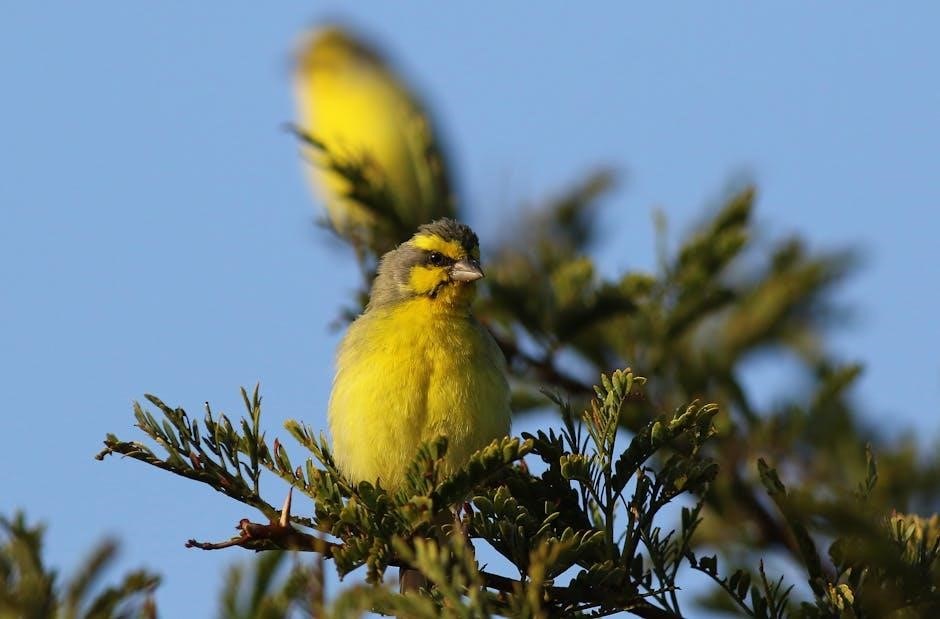
Troubled birds play a crucial ecological role, often serving as indicators of environmental health. Species like the Mincing Mockingbird and Peregrine Falcons highlight ecosystem imbalances through their behaviors and population declines. These birds contribute to seed dispersal, pest control, and maintaining forest dynamics. Their struggles signal broader environmental issues, prompting conservation efforts. Habitat restoration projects, such as those by the Pennsylvania Game Commission, aim to create young forests that support troubled game birds and other wildlife. By addressing their challenges, we protect entire ecosystems, ensuring biodiversity and ecological balance. The Guide to Troubled Birds emphasizes their importance in maintaining nature’s equilibrium, urging action to preserve these vital species.
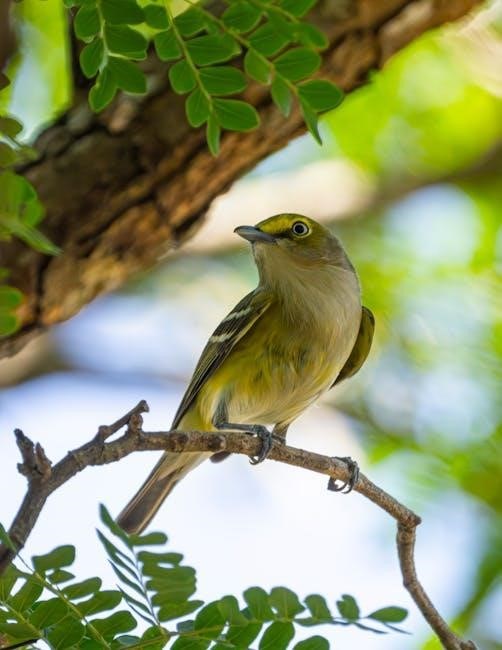
Behavioral Traits of Troubled Birds
Troubled birds exhibit behaviors such as aggression, feather plucking, and unusual vocalizations, often linked to environmental stressors and genetic factors, as detailed in the guide.
Aggressive Behavior in Birds
Aggressive behavior in birds, as noted in the Guide to Troubled Birds, often stems from environmental stressors such as habitat loss or human interference. Species like the Peregrine Falcon, when placed in urban environments, may exhibit heightened aggression due to competition for resources. Similarly, Bourke’s Parrot mutations can sometimes correlate with behavioral changes, including increased aggression. This behavior is not merely a survival instinct but also a sign of broader ecological imbalances. Understanding these patterns is crucial for developing effective conservation strategies and ensuring the well-being of troubled bird populations. By addressing root causes, such as habitat restoration, we can mitigate aggressive behaviors and promote healthier bird communities.
Feather Plucking and Self-Mutilation
Feather plucking and self-mutilation are distressing behaviors observed in troubled birds, often linked to environmental stress or genetic factors. The Guide to Troubled Birds highlights such behaviors in species like the Mincing Mockingbird and Bourke’s Parrot, where mutations may exacerbate these traits. These actions can signify deeper psychological or physical discomfort, potentially stemming from habitat loss or improper care. Addressing these issues requires a holistic approach, including dietary adjustments and environmental enrichment, as outlined in the guide. By understanding and mitigating the root causes, conservation efforts can help reduce such harmful behaviors, ensuring the well-being of these unique avian species and promoting healthier populations. Feather plucking, in particular, serves as a visible indicator of the broader challenges faced by troubled birds today.
Vocalization Issues in Troubled Birds
Troubled birds often exhibit abnormal vocalization patterns, ranging from excessive noise to complete silence. The Guide to Troubled Birds highlights how species like the Mincing Mockingbird and certain parrots develop irregular calls due to stress or genetic mutations. These vocalization issues can signal underlying psychological or environmental challenges, such as habitat disruption or social isolation. In some cases, birds may mimic unnatural sounds or produce distorted calls, reflecting their troubled state. Addressing these issues requires understanding the root causes, such as environmental stressors or improper care. Conservation efforts, including habitat restoration and behavioral enrichment, play a crucial role in mitigating vocalization problems and restoring natural communication patterns in these avian species. By doing so, we can help troubled birds regain their vocal balance and overall well-being.
Social Withdrawal in Birds
Social withdrawal is a common behavioral issue in troubled birds, often manifesting as isolation or reluctance to interact with flock members. The Guide to Troubled Birds reveals that species like the Mincing Mockingbird and certain parrots may exhibit this behavior due to stress, habitat changes, or genetic factors. Social withdrawal can disrupt flock dynamics and impair a bird’s ability to thrive. Environmental enrichment and rehabilitation programs, as discussed in the guide, are critical in helping these birds reconnect with their social nature. By addressing root causes such as isolation or habitat loss, conservation efforts can mitigate social withdrawal and promote healthier, more integrated bird communities. Understanding and resolving this issue is vital for the well-being of troubled birds.
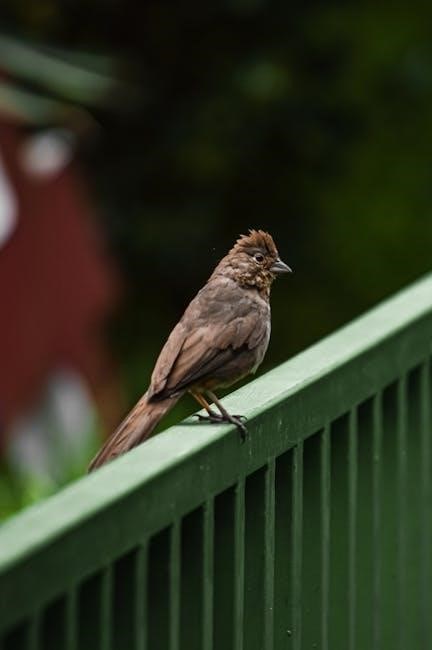
Common Species of Troubled Birds
Troubled birds include species like the Mincing Mockingbird, known for its erratic songs, and Bourke’s Parrot, often exhibiting feather mutations. The Peregrine Falcon faces urban challenges.
The Mincing Mockingbird
The Mincing Mockingbird (Mimus cinctus) is a species known for its unique, yet troubled behavior. Native to tropical regions, it often exhibits irregular vocal patterns, mimicking sounds in a disrupted manner. This bird is prone to stress-induced feather plucking, particularly in captivity, and may develop aggressive behaviors when provoked. Its ecological role involves seed dispersal and insect control, but habitat loss has threatened its populations. Conservation efforts focus on restoring its natural habitats and addressing human-induced stressors. The Mincing Mockingbird’s erratic songs and self-destructive tendencies make it a prime subject for studying troubled avian behavior. Its survival hinges on targeted conservation and research initiatives.
Bourke’s Parrot and Its Mutations
Bourke’s Parrot (Neopsephotus bourkii) is an Australian species known for its striking color mutations. Naturally, it exhibits a brown back with a blue-grey crown and white underside. However, mutations have led to various color variations, including opaline, dilute, and rosy forms. These mutations, often genetic, alter feather pigmentation and patterning. While they enhance the bird’s appeal in captivity, they can also indicate underlying genetic instability. In the wild, such mutations are rare, suggesting they may result from selective breeding in aviculture. Bourke’s Parrot’s adaptability and mutational diversity make it a fascinating yet troubled species, highlighting the intersection of genetics and avian health.
Peregrine Falcons in Urban Environments
Peregrine Falcons (Falco peregrinus) have adapted remarkably to urban environments, thriving in cities worldwide. These apex predators utilize skyscrapers and bridges as nesting sites, mirroring their natural cliff-dwelling behavior. Urban Peregrines feed on pigeons and other birds, benefiting from the abundance of prey in densely populated areas. However, their success is tempered by challenges such as habitat limitations, pollution, and collisions with structures. Despite these obstacles, their resilience has made them a symbol of wildlife adaptability. Urban Peregrines also face unique threats, including lead poisoning from hunting prey contaminated with lead shot. Their presence in cities highlights the complex relationship between wildlife and human-dominated landscapes.
Game Birds in Decline
Game birds, such as grouse, quail, and pheasants, are facing significant population declines due to habitat loss and fragmentation. These birds rely on specific grassland and shrubland ecosystems, which are increasingly being converted into agricultural land or urban areas. Climate change exacerbates these challenges by altering breeding and migration patterns. Overhunting further threatens populations, as many species are targeted for sport despite declining numbers. Conservation efforts are critical to stabilize these populations, including habitat restoration and hunting regulations. Pollution and pesticide use also contribute to declines by affecting food sources and reproductive success. Protecting game birds requires addressing these interconnected threats to ensure their survival and ecological balance.
Conservation and Rehabilitation
Conservation and rehabilitation efforts focus on protecting habitats, rescuing injured birds, and reintroducing species. Collaborative initiatives with wildlife experts, governments, and communities ensure effective long-term solutions.
Habitat Restoration for Troubled Birds
Habitat restoration is critical for troubled birds, focusing on rebuilding natural environments like forests, wetlands, and grasslands. Native plant species are prioritized to ensure biodiversity. Efforts include reforestation, wetland conservation, and removing invasive species. Restored habitats provide shelter, food, and breeding grounds, reducing stress and competition. Collaborative initiatives between conservationists, local communities, and governments are essential. Educational programs also raise awareness about the importance of preserving ecosystems. By restoring habitats, troubled birds gain a fighting chance to recover and thrive, ensuring their survival for future generations.

State-Agency Partnerships for Wildlife
State-agency partnerships play a crucial role in wildlife conservation, particularly for troubled birds. These partnerships involve collaboration between state agencies, NGOs, local communities, and sometimes federal agencies. They focus on pooling resources, expertise, and funding to implement effective conservation strategies. A key aspect is the development of tailored conservation plans for specific bird species, ensuring targeted protection and habitat management. These partnerships also facilitate monitoring and research, enabling data-driven decisions to address challenges faced by troubled birds. Funding is another critical component, with partnerships helping to secure grants and appropriations for conservation projects. Additionally, state-agency collaborations often include educational outreach, engaging communities in conservation efforts and promoting the importance of protecting avian populations. By fostering cooperation and leveraging collective strengths, these partnerships are vital for the recovery and sustainability of troubled bird species.
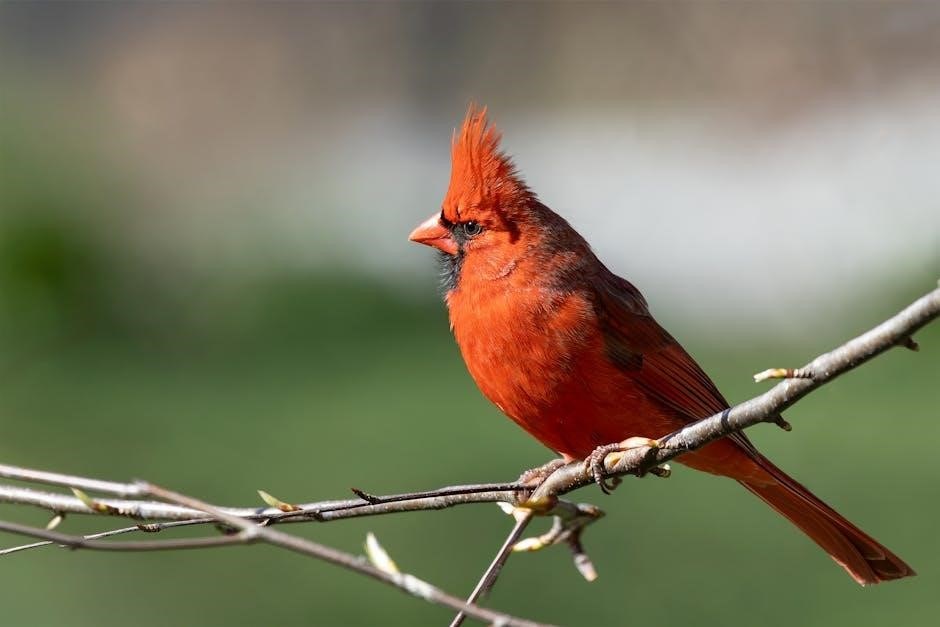
The Role of Rehabilitation Centers
Rehabilitation centers play a vital role in the recovery and care of troubled birds, providing specialized attention to injured, orphaned, or distressed avian species. These centers are equipped with trained professionals, medical facilities, and resources to address physical and behavioral challenges. Their primary focus is to nurse birds back to health, ensuring they can survive independently in the wild. Rehabilitation often involves dietary adjustments, physical therapy, and mental stimulation to restore natural behaviors. Many centers also emphasize the importance of releasing birds back into their natural habitats, fostering ecological balance. Additionally, these centers serve as educational hubs, raising awareness about bird conservation and the impact of human activities on avian populations. Their work is indispensable for the survival and well-being of troubled birds.

Causes of Troubled Bird Behavior
Troubled bird behavior stems from environmental changes, human activities, and genetic predispositions, disrupting their natural habits and leading to distress.
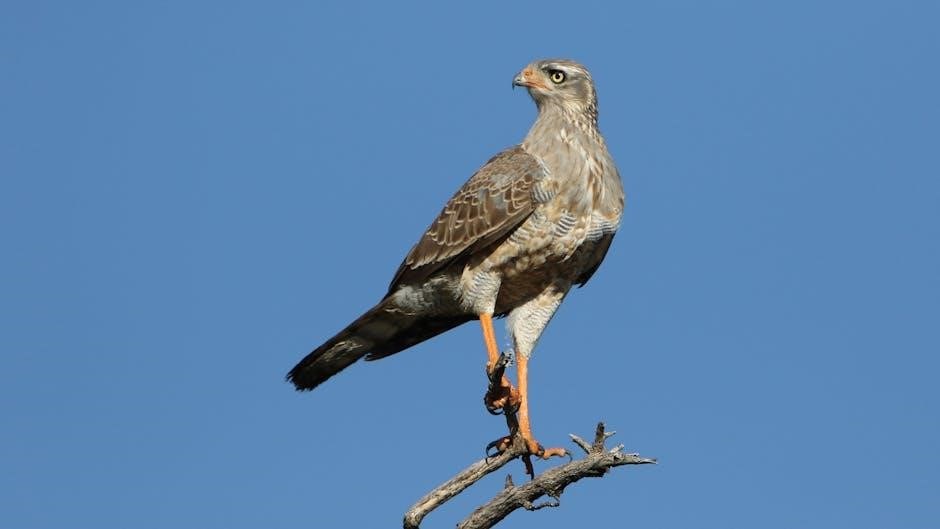
Environmental Stressors
Environmental stressors significantly contribute to troubled bird behavior, often disrupting their natural habits and well-being. Pollution, such as chemical contaminants and noise, can interfere with communication and health. Climate change alters ecosystems, affecting food availability and breeding patterns. Habitat destruction reduces living spaces, forcing birds into unfamiliar or stressful environments. Additionally, invasive species introduce competition and predation pressures. These factors collectively create chronic stress, leading to behavioral issues like aggression, feather plucking, or vocalization problems. Addressing environmental stressors is crucial for mitigating troubled behavior and ensuring the survival of bird populations. Conservation efforts must focus on reducing pollution, preserving habitats, and combating climate change to create a safer environment for birds.
Human Impact on Bird Populations
Human activities significantly impact bird populations, contributing to their troubled state. Habitat destruction due to urbanization, deforestation, and agriculture reduces available nesting and feeding grounds. Pollution from plastics, chemicals, and pesticides contaminates ecosystems, harming birds and their food sources. Overexploitation, such as hunting and poaching, further threatens vulnerable species. Climate change, driven by human emissions, disrupts migratory patterns and breeding cycles. Additionally, human-introduced invasive species outcompete native birds for resources. These actions collectively destabilize bird populations, leading to behavioral and physiological distress. Mitigating human impact requires sustainable practices, stricter regulations, and global cooperation to protect avian diversity and ecosystems. Addressing these issues is essential for the long-term survival of troubled bird species.
Genetic Factors in Troubled Birds
Genetic factors play a significant role in the behavior and health of troubled birds. Mutations, inbreeding, and inherited traits can lead to abnormal behaviors such as feather plucking, aggression, and social withdrawal. In some species, genetic predispositions make birds more susceptible to stress, which exacerbates troubled behaviors. For example, certain parrot species exhibit self-mutilation due to genetic abnormalities. Additionally, a lack of genetic diversity in captive populations can weaken immune systems, making birds more vulnerable to diseases. Conservation efforts often focus on maintaining genetic diversity to reduce these issues. Understanding genetic factors is crucial for developing effective breeding and rehabilitation programs to help troubled birds thrive.
Solutions and Interventions
Effective solutions for troubled birds involve targeted interventions, conservation efforts, and rehabilitation programs. Collaboration between experts and education on bird care are essential for success.
Dietary Adjustments for Troubled Birds
Dietary adjustments play a critical role in addressing behavioral and health issues in troubled birds. Providing a balanced and nutrient-rich diet can help stabilize their emotional and physical well-being. A customized diet tailored to the bird’s species, age, and specific challenges is essential. This may include fortified pellets, fresh fruits, vegetables, and calcium supplements to address deficiencies. Avoiding high-sugar foods and processed treats is crucial, as these can exacerbate agitation and stress. Ensuring access to fresh water and natural foraging materials can also promote mental stimulation and reduce problematic behaviors. Consulting with a veterinarian or avian nutritionist is vital to create a diet plan that supports recovery and long-term health.
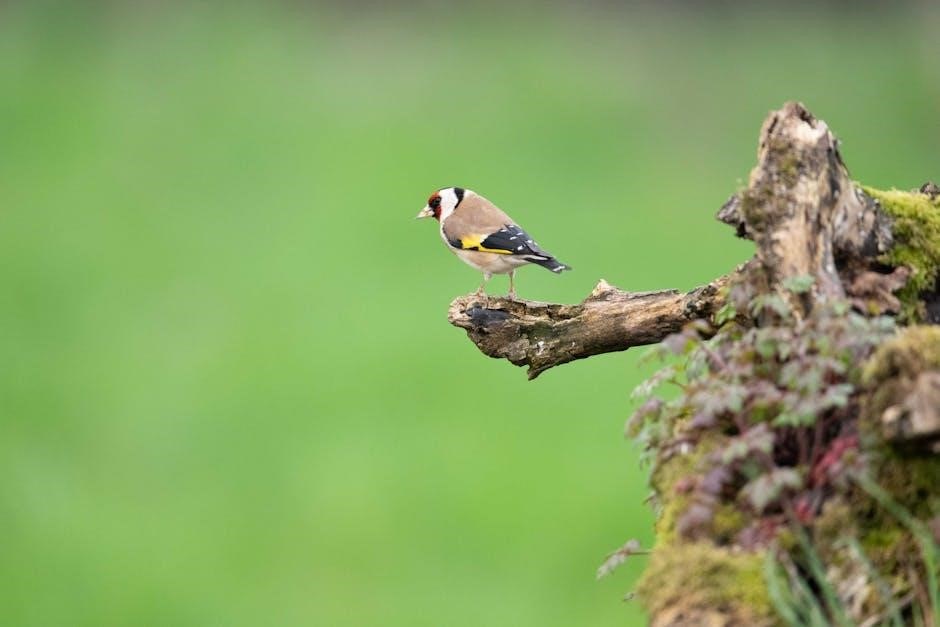
Environmental Enrichment Strategies
Environmental enrichment strategies are vital for improving the mental and emotional well-being of troubled birds. These strategies focus on creating stimulating environments that mimic natural habitats, reducing stress and promoting healthy behaviors. Adding natural perches, nesting boxes, and interactive toys can encourage exploration and exercise. Introducing plants, branches, and sensory-rich materials like sand or water features can also provide mental stimulation. Rotating enrichment items regularly keeps the environment dynamic and engaging. Additionally, providing opportunities for foraging and problem-solving, such as hidden food or puzzle feeders, can distract from negative behaviors and foster a sense of purpose. These interventions help troubled birds regain balance and thrive in their surroundings.
Understanding and addressing the challenges faced by troubled birds is crucial for their survival and well-being, ensuring a brighter future for these vital creatures in our ecosystems.
The Importance of Understanding Troubled Birds
Understanding troubled birds is essential for their conservation and the health of ecosystems. These birds often serve as indicators of environmental health, reflecting broader ecological challenges. By studying their behaviors, habitats, and struggles, scientists can develop targeted strategies to address declines and improve survival rates. Troubled birds also play critical roles in pollination, seed dispersal, and pest control, making their preservation vital for biodiversity. Additionally, their unique behaviors and adaptations offer insights into evolutionary processes. Public awareness and education are key to fostering empathy and support for conservation efforts. Protecting troubled birds not only benefits the species but also ensures the balance and resilience of ecosystems worldwide.
Future Prospects for Bird Conservation

Future prospects for bird conservation hinge on addressing habitat loss, climate change, and human-induced stressors. Emerging technologies, like satellite tracking and genetic research, offer promising tools to monitor and protect bird populations. Global collaborations and policy reforms are essential to safeguard migratory routes and breeding grounds. Public awareness campaigns can inspire community-driven conservation efforts. By integrating science, policy, and community engagement, the future holds hope for stabilizing troubled bird populations and ensuring their survival. Continued research and innovation will be key to overcoming current challenges and fostering a sustainable coexistence between birds and humans.
